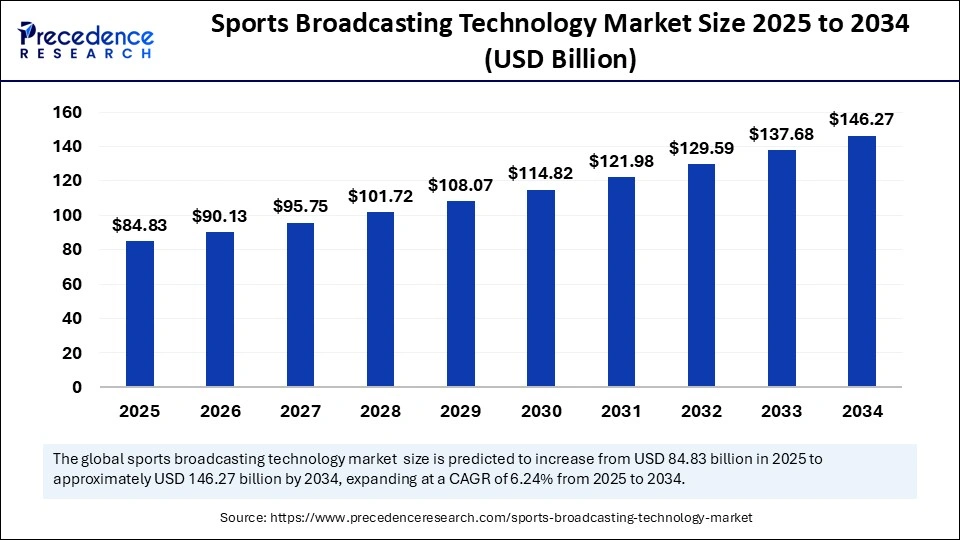
- North America dominated the sports broadcasting technology market with the largest share of 37% in 2024.
- Asia Pacific is projected to host the fastest-growing market in the coming years.
- Europe is anticipated to witness notable growth in the global market.
- By component, the solutions segment led the global market in 2024.
- By component, the services segment is projected to expand rapidly in the coming years.
- By technology, the digital segment held a biggest market share of 78% in 2024.
- By technology, the analog segment is expected to grow rapidly during the forecast period of 2025 to 2034.
- By platform, the television segment dominated the global market in 2024.
- By platform, the OTT platform segment is projected to grow at the fastest CAGR in the future years.
- By end-use, the broadcasters segment led the global market in 2024.
Market Overview
The sports broadcasting technology market is expanding rapidly as technological innovation revolutionizes the way audiences experience live sports. Viewers today expect more than just standard coverage; they demand interactive, personalized, and immersive content delivered seamlessly across multiple platforms. Technological advances in ultra-high-definition (UHD) broadcasting, cloud computing, artificial intelligence, and augmented reality are pushing the boundaries of sports coverage. This market is at the intersection of media, technology, and sports entertainment, creating numerous opportunities for broadcasters, tech vendors, and rights holders alike.
Drivers
A major driver of the sports broadcasting technology market is the consumer preference for on-demand and mobile viewing experiences. The explosion of OTT platforms offering sports content has created fierce competition, pushing traditional broadcasters to upgrade their technological capabilities. Innovations such as 5G technology are enhancing live streaming experiences by enabling faster data transmission with minimal latency. Furthermore, the demand for real-time data and enhanced viewer engagement through features like live stats, player tracking, and augmented reality graphics is increasing the reliance on sophisticated broadcasting solutions.
Opportunities
Significant opportunities are emerging in personalized and interactive broadcasting technologies. Leveraging AI to offer individualized content recommendations, personalized camera angles, and customized highlights represents a major growth area. Another opportunity lies in the monetization of content through targeted advertising and subscription-based models powered by advanced data analytics. Moreover, advancements in virtual and augmented reality technologies could redefine fan experiences, especially in remote and global markets. Collaborations between technology startups and major sports organizations are fostering an environment ripe for innovation.
Challenges
However, the sports broadcasting technology market faces several obstacles. High costs associated with technology upgrades, rights acquisition, and content production remain critical barriers. Cybersecurity threats and the protection of digital assets are growing concerns as content increasingly moves online. Maintaining service quality and low latency across global networks is a technical challenge, particularly in regions with underdeveloped infrastructure. Furthermore, shifting consumer behaviors, such as the decline of traditional cable subscriptions in favor of digital platforms, require continuous adaptation by broadcasters.
Regional Insights
North America remains a leader in the sports broadcasting technology market due to its high sports consumption rates and significant investments in digital innovation. Europe is close behind, fueled by strong sports traditions and a tech-savvy audience, particularly in football (soccer) broadcasting. Asia-Pacific is emerging as a hotspot for growth, led by rising internet penetration, a young population, and a passion for diverse sports. South America, the Middle East, and Africa offer long-term potential as increasing sports fandom and mobile technology adoption drive new viewing behaviors.
Recent Developments
Recent developments in the sports broadcasting technology market highlight a trend toward hybrid broadcast models that combine traditional television with digital streaming. Companies are adopting AI and machine learning tools to automate content editing and improve audience targeting. Innovations such as holographic displays and interactive live chats are beginning to surface in premium broadcasts. The COVID-19 pandemic accelerated the adoption of remote production tools, a trend that is now becoming permanent. Additionally, sports leagues are exploring direct streaming models, bypassing traditional media companies to reach audiences directly.
Sports Broadcasting Technology Market Companies
- Broadcast Electronics (Elenos S.r.L.),
- IBM Corporation
- Staige GmbH
- Rohde and Schwarz
- AvL Technologies
- OMB Broadcast
- Global Invacom
- Hangzhou HAOXUN Technologies Co., Ltd.
- ETL System Ltd.
- NEC Corporation
- VSN Video Stream Networks S.L.
- Sportradar AG
Segments Covered in the Report
By Component
- Solutions
- Software
- Hardware
- Dish Antennas
- Amplifiers
- Switches
- Encoders
- Video Servers
- Transmitters/Repeaters
- Modulators
- Others
- Services
By Technology
- Analog
- Digital
By Platform
- OTT
- Radio
- Television
- Satellite Direct-to-Home
- Digital Terrestrial Television (DTT)
- Cable Television
- IPTV
By End-User
- Broadcaster
- Studios and Content Developer
- Distributors
By Region
- North America
- Asia Pacific
- Europe
- Latin America
- Middle East and Africa